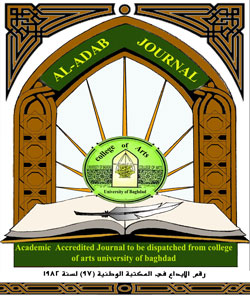The Argumentative Scales in the Verses that Respond to Doubts of the Skeptics in Surat Al-Ma'idah (The Table Spread) and Al-An’am (The Cattle)
DOI:
https://doi.org/10.31973/w5g2d244Keywords:
Argumentation, Argumentative Scales, Hierarchy, Surat Al-Ma’idah, Surat Al-An’amAbstract
Arguments vary in their levels in terms of strength and weakness and their connection to the result they lead to. These arguments help in drawing conclusions because of the specific direction that they oblige the recipient to. This study aims to address the theory of the argumentative scales developed by Oswald Ducrot by highlighting the concept of the argumentative scales, its characteristics and laws, and investing the theory in analyzing Qur’anic texts in order to explore the hierarchy of arguments and their connection to each other, resulting in arguments that direct the recipient to the desired result, influence the recipient, and lead to persuasion. We will take the verses that respond to the doubts of the skeptics in Surat Al-Ma’idah and Al-An’am as a subject for the study.
Downloads
References
بصل، محمد، والعكش، أسامة (٢٠١٨م)، نظريّة الحجاج اللّغوي عند ديكرو وانسكومبر، مجلة جامعة تشرين للبحوث والدراسات العلمية – سلسلة الآداب والعلوم الإنسانية، اللاذقية، مج٤٠، ع٤. ص١٩٤.
حسيني، مختار (٢٠٢٠م)، الحجاج اللغوي بين النظرية والتطبيق: آيات من سورة آل عمران نموذجًا، ضاد - مجلة لسانيات العربية وآدابها، تركيا، مج١، ع٢، ص٧٩-٨١.
ديكرو، أوزفالد (2010م)، لسانيات الخطاب: الأسلوبية والتلفظ والتداولية (إشراف: صابر حباشة)، دار الحوار للنشر والتوزيع، سورية.
الرازي، فخر الدين أبو عبد الله محمد (١٤٢٠ه)، مفاتيح الغيب ج١١ (الطبعة الثالثة)، دار إحياء التراث العربي، بيروت.
السرتي، زكريا (٢٠١٤م)، الحجاج في الخطاب السياسي المعاصر، عالم الكتب الحديث للنشر والتوزيع، إربد.
السُّريح، فايز بن سياف (٢٠١٩م)، البيِّنات في علم المناسبات، مدار القبس للنشر والتوزيع، الرياض.
الشهري، عبد الهادي بن ظافر (٢٠٠٤م)، استراتيجيات الخطاب: مقاربة لغوية تداولية، دار الكتاب الجديد المتحدة، بيروت.
صادق، مثنى كاظم (٢٠١٥م)، أسلوبية الحجاج التداولي والبلاغي: تنظير وتطبيق على السور المكية، منشورات ضفاف، بيروت.
الطبري، أبوجعفر محمد (٢٠٠١م)، جامع البيان عن تأويل آي القرآن ج٧ (تحقيق: محمود شاكر)، دار إحياء التراث العربي.
ابن عاشور، محمد الطاهر بن محمد (١٩٨٤م)، التحرير والتنوير ج١٤، الدار التونسية للنشر، تونس.
عبد الرحمن، طه (١٩٩٨م)، اللسان والميزان أو التكوثر العقلي، المركز الثقافي العربي، الدار البيضاء.
العزاوي، أبوبكر (٢٠٠٦م)، اللغة والحجاج، العمدة في الطبع.
قادا، عبد العالي (٢٠١٥م)، الحجاج في الخطاب السياسي: الرسائل السياسية الأندلسية خلال القرن الهجري الخامس أنموذجًا (دراسة تحليلية)، دار كنوز المعرفة للنشر والتوزيع، عمان.
القرطبي، أبو عبد الله محمد (١٩٦٤م)، الجامع لأحكام القرآن ج٧ (تحقيق: أحمد البردوني وإبراهيم أطفيش)، (الطبعة الثانية)، دار الكتب المصرية، القاهرة.
ابن كثير، أبوالفداء إسماعيل (١٤١٩هـ)، تفسير القرآن العظيم ج٣ (تحقيق: محمد حسين شمس الدين)، دار الكتب العلمية، منشورات محمد علي بيضون، بيروت.
المبخوت، شكري (ب. ت)، أهم نظريات الحجاج في التقاليد الغربية من أرسطو إلى اليوم، جامعة الآداب والفنون والعلوم الإنسانية، كلية الآداب – منوبة، تونس.
مجموعة من الباحثين (٢٠١٠م)، الحجاج مفهومه ومجالاته: دراسات نظرية وتطبيقية في البلاغة الجديدة ج١ (إشراف: حافظ اسماعيلي علوي)، عالم الكتب الحديث، إربد.
موشلر، جاك، وريبول، آن (٢٠١٠م)، القاموس الموسوعي للتداولية (ترجمة: مجموعة من الأساتذة والباحثين)، دار سيناترا، تونس.
Ducrot, O (2009) Slovenian Lectures: Introduction into Argumentative Semantics. Educational Research Institute.
Henkemans, A.F., Eemeren, F.H, & Grootendorst, R (2002) Argumentation: Analysis, Evaluation, Presentation. Lawrence Erlbaum Associates. Mahwah, NJ, London.
Perelman, C, & Tyteca, L (1991). The New Rhetoric: A Treatise on Argumentation. Translated by: John Wilkinson & Purcell Weaver. University of Notre Dame Press, Notre Dame.
Plantin. C (2021). Dictionnaire de l'argumentation. Scale: Argument Scales — Laws of Discours. Retrieved from: http://icar.cnrs.fr/dicoplantin/scale-argumentative-scales-laws-of-discourse-e/ on 30/9/2023.
Downloads
Published
Issue
Section
License
Copyright (c) 2024 مريم سعيد بن طوق المري، د. خالد اليعبودي

This work is licensed under a Creative Commons Attribution 4.0 International License.
Copyright and Licensing:
For all articles published in Al-Adab journal, copyright is retained by the authors. Articles are licensed under an open access Creative Commons CC BY 4.0 license, meaning that anyone may download and read the paper for free. In addition, the article may be reused and quoted provided that the original published version is cited. These conditions allow for maximum use and exposure of the work.
Reproducing Published Material from other Publishers: It is absolutely essential that authors obtain permission to reproduce any published material (figures, schemes, tables or any extract of a text) which does not fall into the public domain, or for which they do not hold the copyright. Permission should be requested by the authors from the copyrightholder (usually the Publisher, please refer to the imprint of the individual publications to identify the copyrightholder).
Permission is required for: Your own works published by other Publishers and for which you did not retain copyright.
Substantial extracts from anyones' works or a series of works.
Use of Tables, Graphs, Charts, Schemes and Artworks if they are unaltered or slightly modified.
Photographs for which you do not hold copyright.
Permission is not required for: Reconstruction of your own table with data already published elsewhere. Please notice that in this case you must cite the source of the data in the form of either "Data from..." or "Adapted from...".
Reasonably short quotes are considered fair use and therefore do not require permission.
Graphs, Charts, Schemes and Artworks that are completely redrawn by the authors and significantly changed beyond recognition do not require permission.
Obtaining Permission
In order to avoid unnecessary delays in the publication process, you should start obtaining permissions as early as possible. If in any doubt about the copyright, apply for permission. Al-Adab Journal cannot publish material from other publications without permission.
The copyright holder may give you instructions on the form of acknowledgement to be followed; otherwise follow the style: "Reproduced with permission from [author], [book/journal title]; published by [publisher], [year].' at the end of the caption of the Table, Figure or Scheme.











